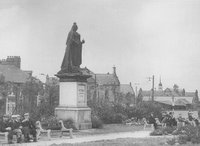

Whilst wandering more or less aimlessly around Stalybridge shopping centre this afternoon, in the time honoured manner of pedestrians everywhere, I happened to notice that quite a lot of shops had shut; had the shutters up and had the look of being more or less abandoned.
Looking more carefully now, I noticed quite a lot of rubbish in the pedestrianised part; Melbourne Street. Nothing new in that, I hear you cry, but it was. I come to Stalybridge, a small town on the edge of Manchester, actually in the county of Cheshire, and once the home of huge steelworks and a major junction on the Manchester to Leeds railway line, once a year and never miss. I notice such things because I look out for them.
I like to say to myself, “Nothing much has changed – none for the worse, and in a few ways, usually for the better.” A few years ago, for instance, I was amazed at the changes wrought by opening the canal straight through the middle of the town, slicing in half what had been a factory making electric cable, together with its car parking areas for its shift workers. So changed was it on that occasion, I remember, that I actually had difficulty orienting myself. It was only when I found familiar landmarks – Trinity church, the market hall, and a few public houses, that I realized where I was and quickly mind-mapped the area.
I look at the changes in the shops and their bright fronts, noting happily that some remain exactly as they were when I lived in the town; too many years to recount now.
This time, I noticed the obvious; a few more public houses have opened, the Palace cinema is now ‘Rififi’ a night club in which you are invited to watch England play Sweden or eat chilli con carne over a glass of Rhennish.
The less obvious takes a little longer to sink in, but I found myself kicking crisp packets, Coca Cola cans and the like, together with that most ubiquitous of unwanted substances; second hand chewing gum.
“There’s more rubbish,” I thought, and looked harder at the town I love.
Sure enough, if you look for something, you find it. Driving a Volkswagen Beatle years ago, I found the whole area choc-a-bloc with them. Changing my VW for a Toyota Corolla, I discovered that half the town’s population of motorists had done the same. You see what it is you are looking for. I searched for more rubbish and saw it everywhere. I wish it were otherwise, but that’s the truth.
Now, the impression I had gained from the closed shops, plus the increase in rubbish (which suggests a corresponding decrease in persons working for the town’s cleansing department) was of a less popular, less populated town centre.
Once I notice a change, even an imagined change, like that one, I start to think of reasons for that change. Changes like that don’t just happen for no reason – people behave rationally, are creatures of habit, and have well formed routines they adhere to, week in, week out. –there must be a reason.
If you travel around the north of England as I do every summer, and if you talk to folk on buses and on park benches, as I also do, you will soon discover an increase, almost amounting to a biblical plague, of new supermarkets and their larger, more-well stocked versions, hypermarkets.
All the usual suspects, as everyone says at the drop of a hat, are there; Tesco, Sainsbury’s, Asda and Morrisons. There must be a need for them, or they wouldn’t open them, or at least they wouldn’t survive in that most cut throat of all competitive markets, the rush to get shoppers through their white sliding doors into their brightly lit, air-conditioned aisles. People eat, they have to buy food, but it doesn’t end there, as you know.
These days, and for a long time now, if you want anything from a pin to an Axminster carpet, you can find it somewhere under the yawing roof and wide bays of a supermarket, and what is more, you know you can find it.
Gone are the days when you wandered around a town centre looking for your shagpile or a needle with which to darn that hole in your left sock (who these days darns socks anyway?). Instead, you get the car out, pile the family in and off you go to the same place as half the town – you go to a supermarket.
Returning now to our somewhat neglected town centre, the question I now ask is this: Who goes to the centre of town, and why? The answer is a simple but instructive one, particularly when trying to find reasons for its gradual desertification. The only people who go into town centres are people who have to: chaps on their way home from work, women who work in the shops there, tourists (in this case, people off canal long boats, who, not knowing the area, pick up what bit of shopping they forgot at their own supermarket prior to joining the boat), and blokes like me; browsers, and loafers, that’s s who! Your determined, bargain driven shopper goes nowhere near.
To be fair about this, you really can’t blame the deserters of the sinking ship; the shops close just before they get out of work, there’s nowhere to park – nowhere that’s free, that is, and even if one or two shops are still open, they sell stuff you can get much, much cheaper in the aisles that are brightly lit and air conditioned.
The advent, the massive advent of supermarkets has sounded the death knell for town centre shops – for any other type of shop, for that matter.
Further out of town, the corner shop is largely becoming a thing of the past. The motorist is king in these outlying suburban sprawls of des-reses, and the supermarket caters for all; Mum can get her hair done, Dad can buy his favourite tipple and the kids can gloat over what children gloat over these days: computer games, DVDs, CDs, computer games (I’ve said that once, haven’t I) and the like.
But don’t take my word for all this; have a look next time you’re in town – sorry, you don’t know the right exit on the motorway to get there – that figures.
Robert L. Fielding



















































